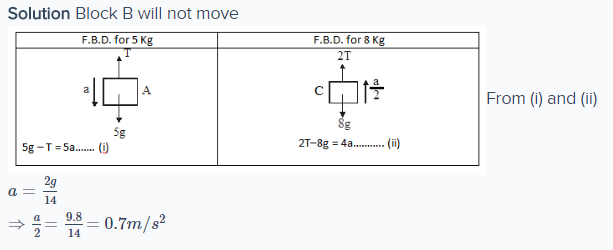Question is given below ?
The question is the following arrangement the system is initially at rest. The 5 kg block is now released. Assuming the pulleys and strings to be massless and smooth, the acceleration of block 'C' is , the diagram is given 
now the solution of this question is also give but how can this possible since B is grounded .
Solution which is given :-

The question is the following arrangement the system is initially at rest. The 5 kg block is now released. Assuming the pulleys and strings to be massless and smooth, the acceleration of block 'C' is , the diagram is given
now the solution of this question is also give but how can this possible since B is grounded .
Solution which is given :-
2 Answers
See below.
Explanation:
Considering
The movement for
The movement for
Now due to the inextensible strings
Now solving
gives
and finally
NOTE
Only point of contention appears to be acceleration
it is difficult to understand this with the help of Newtonian Mechanics. It is clearer if we use Euler-Lagrange equations and use Lagrangian mechanics
However, to appreciate this in terms of Newtonian mechanics,
if both masses
it is clear that
#veca_A=-veca_B# .....(1)
This is due to the fact that string joining the masses is inextensible and therefore, its length is always constant. (1) is purely an outcome of conservation of length even though
By the same conservation of length, if all three masses are moving then
#veca_C=-(veca_A+veca_B)/2# ......(2)
In our problem,
#veca_C=-veca_A/2#
This explains the FBD of block

